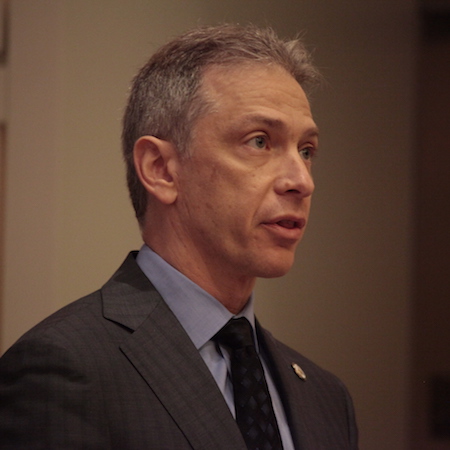USPTO issues patent eligibility guidance
 The Federal Register Notice signed by Director Iancu on April 18, 2018, which relates to the Federal Circuit’s recent decision in Berkheimer v. HP Inc., 881 F.3d 1360 (Fed. Cir. 2018), officially published on Friday, April 20, 2018. It is good news for patent owners with computer-implemented inventions and promises to bring a much more structured prosecution pathway.
The Federal Register Notice signed by Director Iancu on April 18, 2018, which relates to the Federal Circuit’s recent decision in Berkheimer v. HP Inc., 881 F.3d 1360 (Fed. Cir. 2018), officially published on Friday, April 20, 2018. It is good news for patent owners with computer-implemented inventions and promises to bring a much more structured prosecution pathway.
“The USPTO has issued today a Federal Register notice and memorandum to the patent examining corps in response to a recent decision by the U.S. Court of Appeals for the Federal Circuit in Berkheimer v. HP Inc., 881 F.3d 1360 (Fed. Cir. 2018), pertaining to subject matter eligibility,” explained Paul Fucito, a spokesman for the United States Patent and Trademark Office in the Office of Communications. “This new guidance pertains to the second step of the Alice-Mayo framework for determining subject matter eligibility, and is focused on how examiners are to analyze and document a conclusion that a claim element is ‘well-understood, routine, conventional’ during the patent examination process.”
Berkheimer is obviously an important and helpful decision from the patentee’s perspective. The Federal Register Notice appears to also be quite helpful as well. (more…)
Bilski’s Lessons: Three Months Later
 Kenneth W. Brothers, a Partner at Dickstein Shapiro LLP and a presenter at PLI’s upcoming 5th Annual Patent Law Institute, sent in this article he wrote along with Philip G. Hampton, II wherein they discuss what has happened since the Supreme Court’s Bilski decision. Here is an excerpt and a link to the full article.
Kenneth W. Brothers, a Partner at Dickstein Shapiro LLP and a presenter at PLI’s upcoming 5th Annual Patent Law Institute, sent in this article he wrote along with Philip G. Hampton, II wherein they discuss what has happened since the Supreme Court’s Bilski decision. Here is an excerpt and a link to the full article.
After the Supreme Court issued its decision on Bilski v. Kappos, we predicted that much ink would be spilled analyzing the fractured opinions and opaque basis for the majority decision. While the PTO has issued interim guidelines, since June, only one district court has attempted to apply the Bilski decision and the decision has only been mentioned in two Federal Circuit decisions.
Applying Bilski. The patent bar will devote years deciphering this decision, since the majority decision failed to enunciate either a clear standard for patentability under §101 or clear guidelines for determining what is a valid business method patent. We expect that lower court decisions likely will fall into three general categories: (1) adherence to the Federal Circuit’s machine-or-transformation test; (2) seat-of-the-pants determinations of whether the patent-in-suit is directed to abstract; or (3) a genuine attempt to weigh multiple factors to determine patentability. (more…)
01.12.11 | Bilski, Federal Circuit Cases, posts, section 101, USPTO | Stefanie Levine
Supreme Court Rules that Business Methods May be Patentable
Guest Post by Trevor Carter (partner at Baker & Daniels ,Practice Center Contributor and PLI Faculty Member) and Daniel M. Lechleiter ( associate at Baker & Daniels)
On June 28, 2010, the U.S. Supreme Court decided Bilski v. Kappos, an important case involving whether patent claims directed to so-called “business methods” are patentable under U.S. patent law. The case involved a patent application that claimed a method of hedging against the risk of price changes in the energy market. The claims described a series of steps instructing how to hedge risk, as well as the same concept embodied in a mathematical formula. The U.S. Patent Office and all of the lower courts rejected the application as unpatentable, and, because it found that the claims pertain to an “abstract idea,” the Supreme Court agreed.
But, far short of providing clear guidance on how to determine whether a given business method is patentable, the Supreme Court provided high level guidance and left future case by case determinations to lower courts. Thus, while the case makes clear that certain business methods can be patentable, with the exception of very general guidance found in the Patent Act and three of the Court’s prior decisions, it leaves wide open the question of how to distinguish patent-eligible business methods from ineligible ones. This will undoubtedly lead to further litigation and legal experimentation in the lower courts, as they attempt to determine how and where to draw the line between patentable and unpatentable business methods. (more…)


No Comments
05.10.18 | patent eligibility, USPTO | Gene Quinn